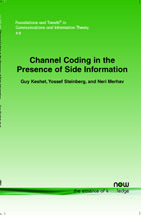Channel Coding in the Presence of Side Information
By Guy Keshet, TraceSpan Communications Ltd., Israel, guy@tracespan.com | Yossef Steinberg, Department of Electrical Engineering, Technion — Israel Institute of Technology, Israel, ysteinbe@ee.technion.ac.il | Neri Merhav, Department of Electrical Engineering, Technion — Israel Institute of Technology, Israel, merhav@ee.technion.ac.il
Abstract
In this survey we review the concepts and methods of communication systems equipped with side information. We focus on the channel coding problem, where side information is available to the transmitter in either a causal or non-causal manner, and we also consider the source coding problem with side information at the receiver.
We first summarize the main results for channels with causal/non-causal side information and the associated capacity formulas. Next, we consider specific channel models, such as Costa's dirty-paper model, the AWGN channel model with fading and the modulo additive noise channel. Further, we provide applications to the models considered here, in particular, we present the watermarking problem and the Gaussian MIMO broadcast channel. We also consider algorithms for the calculation of the channel's capacity, and practical coding schemes for the communication systems explored in this survey. Finally, we study several related information-theoretic problems and present both the Wyner–Ziv and the Slepian–Wolf problems. The source coding problems and the channel coding problems, are presented in a unified version and the duality between the problems is presented. We also present extensions for the MAC and broadcast channel models, to the case where they are controlled by a state process, and consider several hybrid models, e.g., joint source–channel coding for the Wyner–Ziv source and the Gel'fand–Pinsker channel, and the achievable tradeoff between the message and the state information rates.
Channel Coding in the Presence of Side Information
Channel Coding in the Presence of Side Information reviews the concepts and methods of communication systems equipped with side information both from the theoretical and practical points of view. These channels have been widely studied over the years and can serve as models in a wide range of problems, depending on some assumptions regarding the channel state and on the availability and quality (clean or noisy) of the side information at the transmitter and/or the receiver.
Channel Coding in the Presence of Side Information provides a overview of the main theoretical results pertaining to the subject before presenting specific channel models for various problems. It then shows how this theory and models are used in several applications. The authors then discuss some more advanced, related problems including the Wyner-Ziv problem, the Gaussian vector broadcast channel and multi-user channels.
Channel Coding in the Presence of Side Information is a comprehensive review that gives the reader an insightful introduction to one of the most important topics in modern communications systems.
